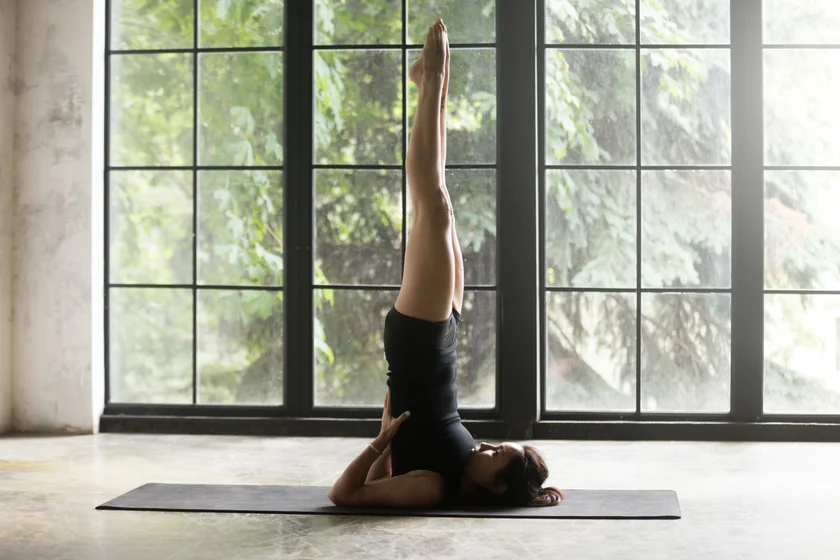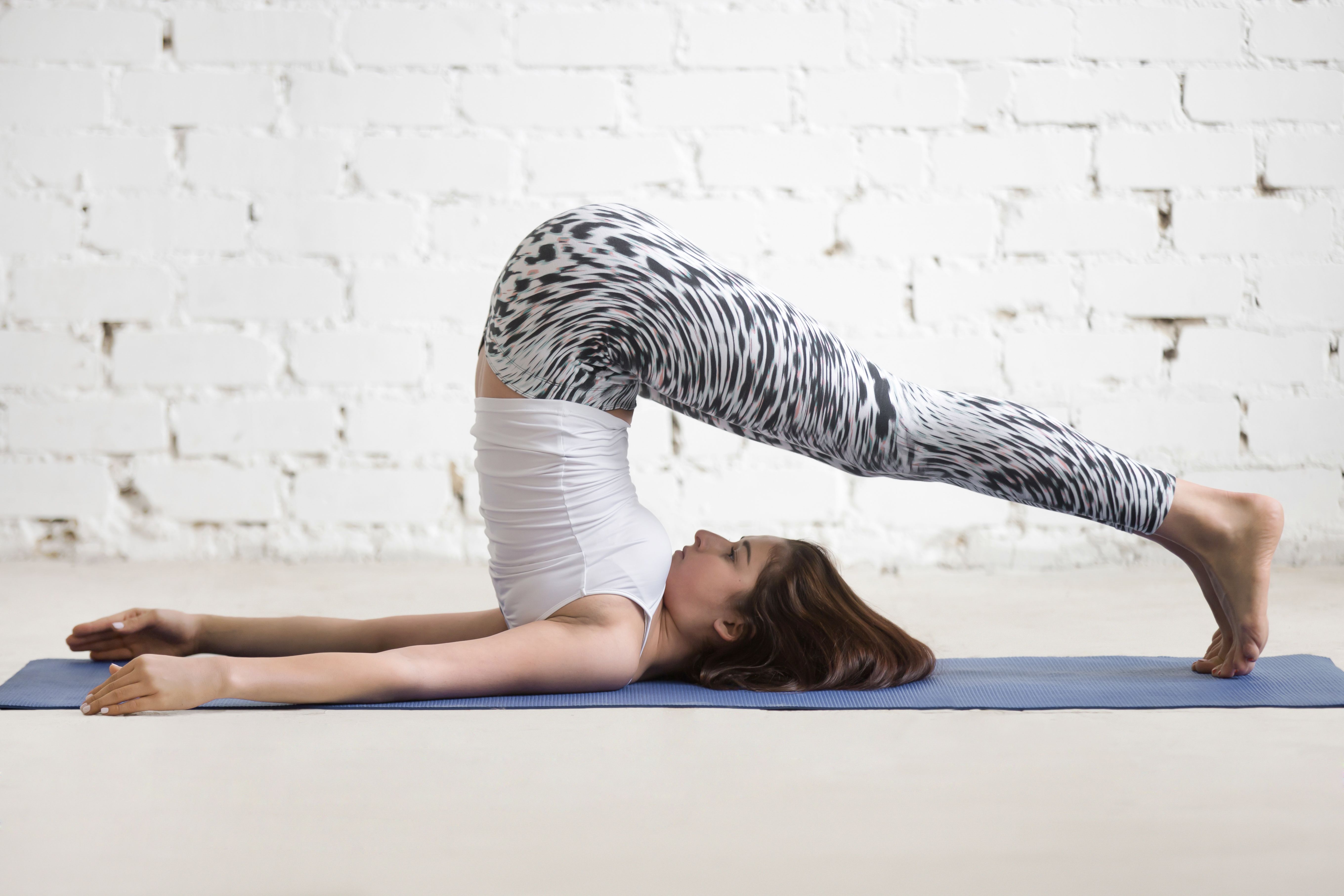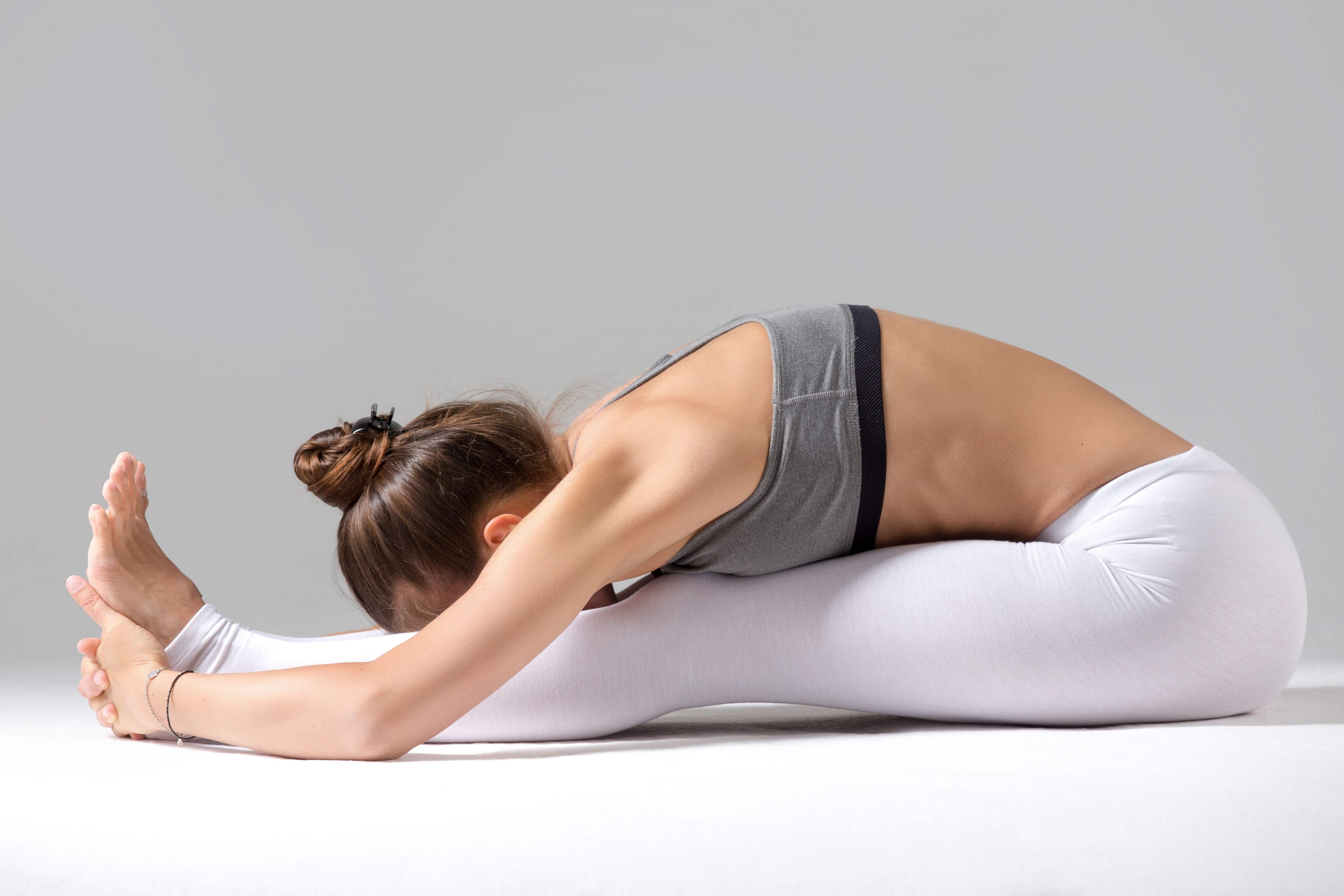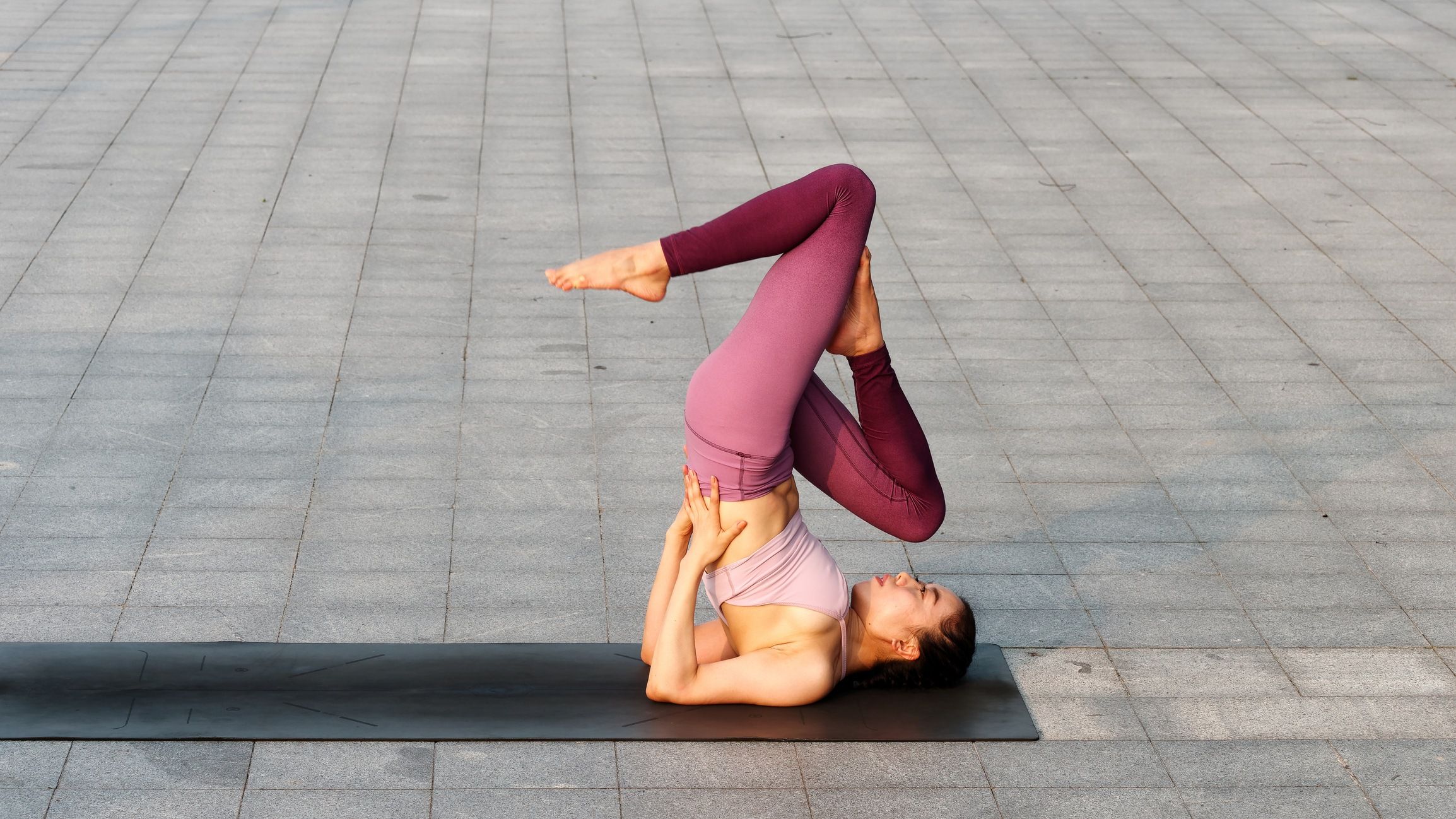What is Sarvangasana (Shoulderstand Pose)?

Sarvangasana, or Shoulderstand, is an intermediate-level inversion pose that belongs to the modern yoga exercise practice. This inversion pose stretches your neck and shoulders while strengthening your abdominal and leg muscles.
Performing this yoga asana offers unique therapeutic benefits for your thyroid gland and respiratory system. Also, as the name implies, Shoulderstand influences your body's overall muscle functioning and health.
Overview & Etymology
The name Sarvangasana originates from Sanskrit words Sarvang which means "all limbs," i.e. the total body, and Asana which means "Posture," "Position," or "Seat.”
The name Sarvangasana is modern, but there were existing similar yoga asanas like this one -- known as Viparita Karani.
Such versions of the Shoulderstand pose were noted in 14th-century Sanskrit text on yoga: Śiva Saṃhitā, 15th-century classic yoga manual: Haṭha Yoga Pradīpikā, and a 17th-century yoga Sanskrit text Gheraṇḍa Saṃhitā.
Yoga scholars have guessed that this modern name Salamba Sarvangasana is mentioned in Krishnmacharya’s book- Yoga Makaranda around 1934.
Sanskrit Name: सर्वाङ्गासन Pronunciation: sar-van-GAHS-anna
Pose Type: Inversion Also known as: Shoulderstand, Salamba Sarvangasana
Strengthens: Vertebral Column, Neck, and Shoulders Stretches: Spine and Shoulders
Health Benefits of Sarvangasana
Improves blood circulation in the whole body.
Increases blood circulation inside the brain.
Strengthens the shoulders, core, back, and neck.
Improves the functioning of reproductive organs.
Improves metabolism and helps in losing weight.
Increases blood flow in the eyes can improve vision.
Improves the flexibility of the spine and strengthens.
Activates proper functioning of the thyroid and parathyroid glands.
Relaxes the brain and helps in reducing symptoms of insomnia.
When to Avoid Performing Sarvangasana
Avoid during menstruation.
Avoid if you have high blood pressure.
Avoid during the final trimester of pregnancy.
Avoid if you have a migraine or severe sinus headaches.
Avoid if you’ve had a recent spine/neck/back/leg surgery.
Avoid if you have spondylosis, a slipped disc, and/or an acute thyroid problem.
Avoid if you have any severe pain around your lower back/neck/shoulder/legs.
How to do Sarvangasana (Shoulderstand Pose)
Anyone who wants to elevate the level of their yoga practice can start performing Sarvangasana. Although it’s not highly suggested for beginner yoga practitioners, you can still begin to build strength with shoulder stand posture modifications and variations.
So, before you start, read and learn about the four different parts of Sarvangasana practice below:
Part 1 - Preparatory Poses for Sarvangasana
Since Sarvangasana is one of the most challenging yoga poses in the Ashtanga yoga practice, it’s important to warm up your body first.
Let's look at three ways you can prepare the essential muscle groups for your Shoulderstand practice.
1. Setubandhasana (Bridge Pose) - Lie on your back and slowly lift your entire core up in the air. In this pose, you’ll support yourself with your hands, feet, and shoulders.

This pose will work on your shoulder, neck, and leg muscles to help you flow better into the final Sarvangasana practice.
2. Ardha Halasana (Half Plough Pose) - Lay down on the yoga mat with your back touching the ground. Now, lift both the legs up in the air.

Make an angle of 90 degrees with your legs, tuck your belly, and keep your entire core tight.
3. Halasana (Plough Pose) -
Continuing from Half Plough Pose, move to the full Plough Pose. Simply drop one leg to the back of your head and then drop your other leg into the same position and hold this pose here.

Make sure your alignment is correct by checking that your knees are placed on top of your ears in a straight line. This pose will activate all the essential muscles that work more extensively in the Shoulderstand.
Part 2: Step-by-Step Instructions to Perform Sarvangasana
Step 1- Lie on your back and bend your knees, with your feet flat on the mat and your arms relaxed at your sides.
Step 2- Keep both the arms flat on the ground and breathe normally at an average pace.
Step 3- Slowly lift your legs and hips off the mat until your legs are perpendicular to the mat like in Half Plough Pose.
Step 4- Now inhale, pressing down through your palms on the ground, and using your hands and triceps to lift and support your hips.
Step 5- Exhale completely and lift your lower back off the mat in a vertical straight line.
Step 6- Pull your shoulder blades into your upper back, keeping your shoulder engaged. Keep your breath constant and smooth.
Step 7- With your head flat on the mat, place your arms behind your back to support your core and legs as you hold yourself upright vertically.
Step 8- Hold this pose upright in the air for a few minutes and then slowly bring your legs and back to the ground again by releasing your hands from the back.
Breath Awareness:
Inhalation: Inhale deeply while lifting your back up.
Exhalation: Exhale while releasing the pose and placing your back on the ground.
Performance Duration for Beginners: Hold the Shoulderstand pose for 20-60 seconds.
Performance Duration for Advanced:
Hold the Shoulderstand pose for 1 to 3 minutes.
Part 3: Things to Keep in Mind
If you are trying the Sarvangasana for the first time, here are a few essential posture cues to be mindful of:
Don't rush into the pose: In the Shoulderstand pose, your shoulders, neck, and spine are very vulnerable. So it's crucial to keep your posture transition very steady and slow, rushing or jerking movement can displace the spine or neck, causing severe damage to the spine.
Use safety props around you: If you struggle with balancing your body upright during Sarvangasana practice, you can modify the pose with fluffy cushions or bolsters around you on the ground. This will ensure that you land safely even if your balance is not perfect.
Part 4: Relaxing Poses After Sarvangasana
Your body flexes at its maximum when you hold the Shoulderstand for longer durations. So it's important to perform resting counterposes to bring your neck and spine back to their original shape. Below are three different poses that will help you relax thoroughly.
1. Savasana (Corpse Pose): After your Sarvangasana practice, lie down with your legs and arms spread in a five-point star posture. Release pressure from each muscle group by sinking your body into your yoga mat.

You can enhance your breathing pattern and close your eyes for a deeper release of tension. The corpse pose is a great resting counterpose because it helps your entire body relax after Shoulderstand practice.
2. Paschimottanasana (Seated Forward Bend):
After the Shavasana practice, raise your upper body and sit in a staff pose on your yoga mat. Keep your spine upright, engage your core, and start to slowly bend forward with a deep inhale.

Once you touch your knees with your forehead, exhale and release any upper body tension by stretching your arms in front of both legs.
3. Balasana (Child Pose): Continue moving from forward bend into a tabletop position on your yoga mat. Slowly sit back on your shins and stretch both arms out front.

This pose will help you relax your spine, shoulder blades, lower back, and arms all at once after a long duration of Shoulderstand holds.
Sarvangasana Variations to Consider
It doesn't matter if you are a beginner or an advanced yoga practitioner, variations are always fun in terms of experimenting with your body's capabilities. Below are some Sarvangasana variations that you can try:
1. Shoulderstand Pose with Bent Legs: If holding your legs upright in the shoulder stand pose places too much pressure on the upper body, try bending your legs from the knees.

This will reduce pressure around your chin, neck, and shoulders, making the lift more stable and balanced for a far longer duration. Once you feel strong enough, try lifting one leg at a time and straightening it to elevate your practice to the final goal.
2. Single-Legged Shoulderstand Pose with Hands-on Back:
This is for intermediate yogis who want to hold the Sarvangasana upright for prolonged durations.

Start by lifting your back higher and then bend both your arms, placing them right in the middle of your back. This variation works as a support mechanism for your core and helps to keep the balance steady for longer.

Enjoy a Free 1-on-1 Session with a Coach!
Receive personalized guidance tailored to your unique fitness goals, live with a dedicated coach—no credit card required.
Frequently Asked Questions about Sarvangasana
Salamba Sarvangasana is a modern-day inverted yoga asana, often performed at the end of an Ashtanga yoga session. The words of this yoga pose are a combination of a few Sanskrit words, like the following:
- Salamba- Supported
- Sarvang- All Limbs
- Asana- Posture
Salamba Sarvangasana is also known as Supported Shouldersatnd Pose. In this pose, the blood circulates towards the brain making it a great pose for mental rejuvenation.
Sarvangasana is also known as "Mother of all Asanas" or "Queen of Asanas," because it is a yoga pose that enhances the organ functioning of the whole body. Plus, this pose is highly therapeutic as it calms the brain, balances hormonal imbalance, and increases the flow of Prana in the body.
Setu Bandha Sarvangasana is a shoulder-supported bridge pose. Your shoulder strength plays a fundamental role in this pose, supporting your whole core as you balance in this posture.
The shoulder-supported bridge pose is also used in preparation for the Sarvangasana and Halasana. The following are the steps of Setu Bandha Sarvangasana:
- Lie down on your back.
- Breathe continuously and engage your core muscles.
- Place both your arms on the side of your waist.
- Bend your legs and place both your feet close to your hips.
- Now, from your palms, feet, and shoulders, lift your core and inhale.
- Hold this pose for a few minutes or as long as you feel comfortable.
- Exhale and release this pose by slowly placing your core back on the ground.
The duration of your Sarvangasana pose depends on the level of your practice. Intermediate yogis can do this pose for 30 seconds to 1 minute, and advanced yogis may hold this inverted position for 3 to 5 minutes, or even more, depending on their comfort zone.
People suffering from high blood pressure, heart problems, slip-disc, spondylosis, shoulder pain, neck pain, sinus pain, migraine pain, or menstrual cramps should not practice Sarvangasana.
The main pose of Sarvangasana is an inverted vertical upright stand that is balanced on the shoulder and sometimes even on both shoulders and arms.
Your chin is locked into your chest, your neck is slightly compressed, and your legs can change their formation depending upon how challenging you want to make this pose.



.webp)
%20(7).jpg)




